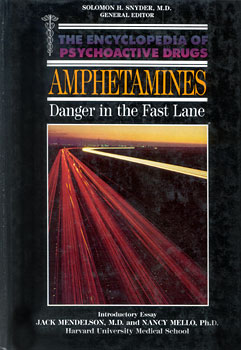
BACK COVER #
In 1932 amphetamine was included as the active ingredient in the Benzedrine inhaler, and the general public was offered a readily accessible source of this powerful drug. Abuse spread quickly and involved many segments of the population -- truck drivers, students, athletes, troops, entertainers, and housewives. Today nearly one-third of all high school seniors have at least tried amphetamine. In low doses amphetamine speeds up the nervous system, thus creating conditions of sleeplessness and high tension; in large doses amphetamine can lead to violent behavior and psychosis. It may also cause convulsions, comas, brain damage, and birth defects. With dependence on amphetamines approaching near epidemic proportions, this book provides a timely and comprehensive review of the drug's effects, history, legal status, and current trends.The Encyclopedia of Psychoactive Drugs answers the questions that young people are likely to ask about drugs, as well as those they might not think to ask, but should. Topics include: what it means to be intoxicated; how drugs affect mood; why people take drugs; who takes them; when they take them; and how much they take. They will learn what happens to a drug when it enters the body. They will learn what it means to get 'hooked' and how it happens. They will learn how drugs affect their driving, their school work and those around them -- their peers, their family, their friends, and their employers. They will learn what the signs are that indicate that a friend or a family member may have a drug problem and to identify four stages leading from drug use to drug abuse.

